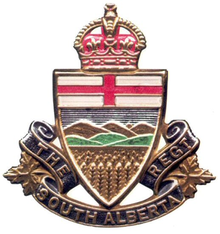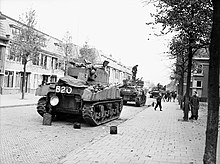
The Queen's Own Rifles of Canada is a Primary Reserve regiment of the Canadian Armed Forces, based in Toronto. The regiment is part of 4th Canadian Division's 32 Canadian Brigade Group. It is the only reserve regiment in Canada to currently have a parachute role. The regiment consists of the reserve battalion, the Regimental Association, and the Regimental Band and Bugles. The official abbreviation is The QOR of C, but the name is often abbreviated to QOR.

The 3rd Canadian Division is a formation of the Canadian Army responsible for the command and mobilization of all army units in the provinces of Manitoba, Saskatchewan, Alberta and British Columbia, as well as all units extending westwards from the city of Thunder Bay.

The 4th Canadian Division is a formation of the Canadian Army. The division was first created as a formation of the Canadian Corps during the First World War. During the Second World War the division was reactivated as the 4th Canadian Infantry Division in 1941 and then converted to armour and redesignated as the 4th Canadian (Armoured) Division. Beginning in 1916 the division adopted a distinctive green-coloured formation patch as its insignia. In 2013 it was announced that Land Force Central Area would be redesignated 4th Canadian Division. It is currently responsible for Canadian Army operations in the Canadian province of Ontario and is headquartered at Denison Armoury in Toronto.

The South Alberta Light Horse (SALH) is a Canadian Army armoured cavalry regiment of the Canadian Army Reserve. It traces its complicated lineage to the Rocky Mountain Rangers, and claims its direct ancestry to the 15th Light Horse, along with various other Alberta based cavalry units. The "Light Horse" designation comes from its light cavalry and mounted infantry origins.

The 10th Canadian Infantry Brigade was a formation of the Canadian Army in both World War I and World War II. The brigade fought on the Western Front during World War I, and in Normandy and north-west Europe during World War II. It formed part of the 4th Canadian Division.

The Canadian Grenadier Guards (CGG) is a reserve infantry regiment in the 34 Canadian Brigade Group, 2nd Canadian Division, of the Canadian Army. The regiment is the oldest and second-most-senior infantry regiment in the Primary Reserve of the Canadian Army. Located in Montreal, its main role is the provision of combat-ready light infantry troops in support of Canadian regular infantry. It is a Household Foot Guard regiment and also provides soldiers for public ceremonial duties, performing similar ceremonial duties as the Guards regiments of the British Army. This primarily entails mounting the guard at Government House, the Governor General's residence, and performing the "Changing the Guard" ceremony on Parliament Hill in Ottawa, a task it shares with Canada's senior Household Foot Guard regiment, the Governor General's Foot Guards of Ottawa. The Canadian Grenadier Guards is an allied regiment to the British Grenadier Guards.

The Royal Hamilton Light Infantry (Wentworth Regiment) (RHLI) is a Primary Reserve infantry regiment of the Canadian Army, based at John Weir Foote VC Armoury in Hamilton, Ontario. The RHLI is part of 31 Canadian Brigade Group, which is part of 4th Canadian Division.

The Royal New Brunswick Regiment (RNBR) is a reserve infantry regiment of the Canadian Army based in New Brunswick. It was formed in 1954 by amalgamation of The Carleton and York Regiment, The New Brunswick Scottish and The North Shore Regiment as the New Brunswick Regiment.The "Royal" designation was added in 1956. The Royal New Brunswick Regiment is part of 37 Canadian Brigade Group, 5th Canadian Division. The RNBR holds 65 battle honours mostly by perpetuation of the regiments it was formed from.
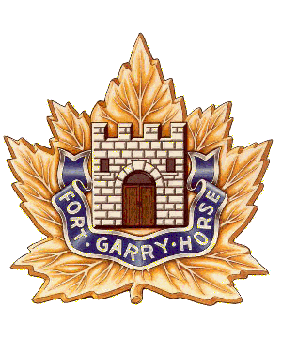
The Fort Garry Horse is a Canadian Army Reserve armoured regiment based in Winnipeg, Manitoba, Canada. It is part of 3rd Canadian Division's 38 Canadian Brigade Group. It traces its history to a cavalry regiment first formed in 1912 that first took up the name "Fort Garry" a year afterwards. Since that time the regiment has served in the First World War, sending men to battalions of the Canadian Expeditionary Force, and as an armoured regiment in the Second World War.

The Argyll and Sutherland Highlanders of Canada (Princess Louise's), or A & SH of C, is a Primary Reserve Highland infantry regiment of the Canadian Forces, based at John W. Foote VC Armoury in Hamilton, Ontario.
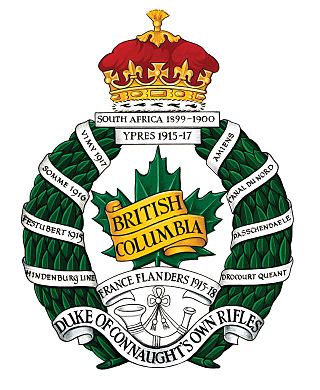
The British Columbia Regiment (Duke of Connaught's Own) is a Primary Reserve armoured reconnaissance (recce) regiment of the Canadian Army; the regiment is subordinate to 39 Canadian Brigade Group of the 3rd Canadian Division. Established in 1883, it is the oldest military unit in Vancouver, British Columbia, Canada. It parades at the Beatty Street Drill Hall at the corner of Dunsmuir and Beatty in Downtown Vancouver. The regiment has been variously designated as garrison artillery, rifles, infantry, and armoured, but has been reconnaissance since 1965. It has received 41 battle honours in its history, and has been a unit of the Royal Canadian Armoured Corps since 1942.

The Royal Winnipeg Rifles are a Primary Reserve one-battalion infantry regiment of the Canadian Army. Nicknamed the "Little Black Devils", they are based at Minto Armoury in Winnipeg, Manitoba. The Royal Winnipeg Rifles are part of 3rd Canadian Division's 38 Canadian Brigade Group.
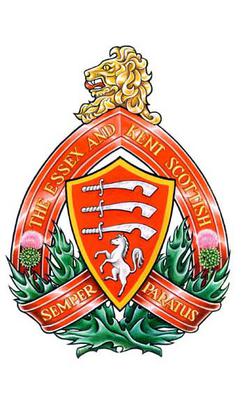
The Essex and Kent Scottish is a Primary Reserve infantry regiment of the Canadian Army.

The Algonquin Regiment (Northern Pioneers) is a primary reserve infantry regiment of the Canadian Army comprising two companies. A Company is located in North Bay, Ontario, and B Company is located in Timmins, Ontario. The regiment falls under the command of the 4th Canadian Division's 33 Canadian Brigade Group.

The 12th Manitoba Dragoons is an armoured regiment of the Canadian Army that is currently on the Supplementary Order of Battle.
The 8th Reconnaissance Regiment , commonly abbreviated to 8 Recce, VIII Recce or 8 Canadian Recce, was the reconnaissance arm of the 2nd Canadian Infantry Division during World War II. The core of the regiment was formed from the militia unit the 14th Canadian Hussars.

The North Shore Regiment is a Primary Reserve infantry regiment of the Canadian Army, and is part of the 5th Canadian Division's 37 Canadian Brigade Group. The regiment is headquartered in Bathurst, New Brunswick, with sub-units located in Newcastle, Campbellton and Moncton.
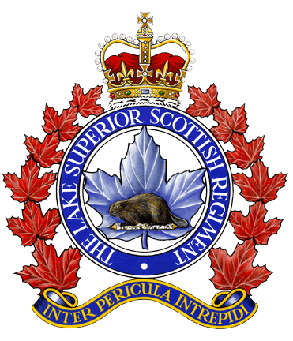
The Lake Superior Scottish Regiment is a Primary Reserve infantry regiment of the Canadian Forces. The regiment is located in Thunder Bay, Ontario, and is part of the 3rd Canadian Division's 38 Canadian Brigade Group. Also known as "The Lake Sups" (pronounced soups), the regiment was active during the First and Second World Wars. During the latter, the regiment, then known as The Lake Superior Regiment or LSR, mobilized a motorized infantry battalion for the 4th Canadian (Armoured) Division; The Lake Superior Regiment (Motor) or LSR(M).
The New Brunswick Rangers was an infantry regiment of the Non-Permanent Active Militia of the Canadian Militia. In 1946, the regiment was amalgamated with The Saint John Fusiliers to form The South New Brunswick Regiment which was later renamed as The New Brunswick Scottish. They now form part of the 1st Battalion, The Royal New Brunswick Regiment.
The Sherbrooke Regiment was a regiment of the Canadian Militia and later the Canadian Army Reserve that existed from 1866 to 1965. Originally an infantry regiment, during the Second World War the regiment helped form the 27th Armoured Regiment (The Sherbrooke Fusilier Regiment) which served as an armoured (tank) unit in the 2nd Canadian Armoured Brigade. In 1946, the regiment itself was converted to an armoured regiment was redesignated as The Sherbrooke Regiment (RCAC). In 1965, the regiment was amalgamated with the 7th/11th Hussars to form The Sherbrooke Hussars.
